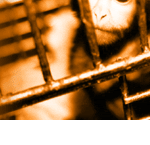Click here to go back.
DANGERS IN GENERALIZING FROM ANIMAL TO HUMAN
Humans have suffered from researchers' reliance on animal models in many ways. Animal data has given us misleading information about how AIDS is transmitted, how it manifests, and how it can potentially be treated.
The inherent flaw in vivisection is that monkeys, rats and other animals are not physiologically identical to humans. Data obtained from experiments on other species cannot be accurately applied to human disease. The research journal Science has this to say about AIDS experimentation on animals:
"No animal models faithfully reproduce HIV-1 infection and disease in humans, and the studies of experimental vaccines in animal models… have yielded disparate results.”1
"There is a big leap from monkeys to humans: for starters, HIV-1, the main AIDS virus that infects humans, differs significantly from SIV…”2
"A molecular clone of the prototype SAIDS virus has no notable similarity in either genetic organization or sequence to the human AIDS retrovirus.”3
Animal data suggested that HIV progressed slowly, with long latency periods. Applying this to human patients, doctors saw no need for aggressive therapy in its early stages. Unfortunately, this was not applicable to humans, as studies of AIDS patients revealed--in humans, the disease progresses quickly with short latency periods. The result: patients were deprived of suitable treatment and died.
Resources used on these animal experiments would have been better spent on legitimate, human-based research methods, or proven-effective prevention programs at home and abroad.








